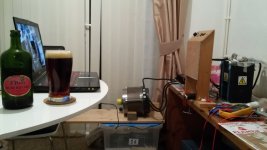Something that I think is not very clear in the manual (have to write a new one anyway

boring)
Field weakening is done automatically and you do not have to take it into account when specifying your max phase current. Lets say you have 100 A sensors and you want max phase current and also some field weakening (lets say 30A).
Then, in the menu structure you can enter 100A for the max phase current and 30A for the field weakening current. You DO NOT have to subtract the 30 from the 100 and only enter 70A max phase current.
First of all, torque current and field weakening current are at right angles to each other, meaning you will have to add them like pythagoras. With 100A total phase current and 30A field weakening current you can still have 95.4A torque current. 30A and 95.4A add up to 100A via pythagoras. Dissipation in the motor wiring with 95.4A torque and 30A fieldweak is based on the total current of 100A, not 125.4A !
Also, the controller does this pythagoras stuff automatically. If you're at low erpm with no field weakening full throttle will get you 100A torque current. As erpm increases field weakening is added unto the 30A from the setup menus. As this is happening the controller does the pythagoras and will, as field weakening current goes from 0 to 30A, automatically reduce torque current (at full throttle) from 100A to 95.4A .


